Spring 2016
Author: tj683
The only word to describe Steve McCurry’s work on display at the Rubin Museum is dramatic. Perhaps there are those that would disagree with me, but I cannot help but notice the “punchiness” of his photos. His photos are aesthetically gorgeous; his cropping and framing are always on point. What is more wondrous, however, is his use of color. You can see in some of his photos where he saturated the overall color in order to highlight the colors of India (see photo below).
We can see in this photo how he most certainly played with he colors of this photograph. The “tell” is in the lady, who looks like she’s been subject to a lasso tool on photoshop:
Some may argue against his editing approach. If you are displaying a work about a group of people, should you be editing or should you keep something fairly “natural”? Of course, RAW images do need slight adjustments, yet when is editing “too much”? Or, does editing help extenuate a message, that the people of India are colorful and diverse.
Regardless, it is an undeniable fact that Steven McCurry knows how to use color well. We can debate the use of his editing, but it is pictures like these that prove McCurry grasps the importance of color:
Here is a perfect example. McCurry took this during the Holi festival, where people throw sachets of color powder as a celebrate activity. Someone might argue, “But Taylor, Holi is inherently colorful!” Just because Holi is a holiday filled with rainbows does not meant that a photographer’s photo of the day will inherently be “great” just because there is color bursting everywhere. Here, McCurry creates a great visual story by introducing a quasi-dichotomy into the narrative of this image. The stark contrast between the bright green and the rich red is more powerful than if McCurry shot an image of all the different colors sachets used during Holi (red, orange, yellow green, blue, purple, etc.). Having a rainbow image would be beautiful, but almost too overwhelming: focusing on just red and green helps the viewer understand that the time is very colorful, while also allowing him/her to see the expression on the green man’s face (happiness).
The image of the woman holding a child in the rain is also another image where McCurry demonstrates his understanding of color. Why most of the image uses an analogous color scheme, McCurry introduces a pop of bright red. While the idea is slightly reminiscent of the cheesy Bed Bath & Beyond black and grey photos of London (with the old red phone booth being the only subject that’s in color), McCurry manages to use the red in a seamless manner.
The strategic use of red in this image helps draw the viewer in; to stun us first, and to have us ask questions later. Questions, such as, why is the woman peering into the (apparent) taxi? Is she looking to see if someone is not inside, so she can use it? Why did she not bring an umbrella out with her that day?
As a whole, McCurry’s use of color in his works shows the vitality of the area, and how vast/diverse the nation can be. India is quite a large space that is filled with different castes, traditions, cuisines, and expressions. His colors also demonstrate the beauty that can be found in any pocket of life; for example, we can find beauty in the simplicity of a woman holding her child, perhaps calling a taxi. What I love about this work is that it shows just how unique photography can be, and how each photographer can have their own “signature.” McCurry’s works (think: his image of the Afghan girl) typically rely on the visual voice of the people, while also utilizing color to push the narrative. In comparison to another photographic work we discussed, Ashley Gilbertson’s Bedrooms of the Fallen, we can see where the author’s “touch” comes into play.
While McCurry’s piece focus on the vitality of the people, Gilbertson’s focuses on the absence of the subject. One can debate that Gilbertson’s images of the bedrooms reveal the complexity of the lives of each fallen soldier, what truly matters is that they are gone. Their bedrooms remain, but they have disappeared.
Unlike McCurry’s vibrant images, Gilbertson uses a minimalist approach to tell his story. Thought the entire piece, he chooses to keep his work black and white. The absence of color can symbolize a multitude of things: the absence of the soldier in his/her family’s life, the absence of metaphorical “color” from the families’ lives, and the idea of the room being a “snapshot” in history.
What is important to note between McCurry or Gilbertson is that the use or absence of color can affect the interpretation and the resonance of the work. Both India and Bedrooms of the Fallen are strong visual stories, yet their use of colors and hues is completely different. As photographers ourselves, we must remember how every little detail (not just color, but even cropping) in our images can affect the story and the impact on the viewer. As Picasso once said, “When I haven’t used any blue, I use red.”
I’ve always treated photography as “capturing a moment.” In addition, I’ve felt that photography has lost this aspect as of late. With camera phones taking exceptional pictures, and with digital SLRs becoming more ubiquitous and cheap, I’ve felt that photography has declined in some small way.
I’d have to say that viewing the VII website helped restore my faith in some way. Of course I seem pessimistic because I am biased towards a certain type of photography. Yet, VII photographers seem to be excellent at “capturing a moment” — the idea of freezing a moment of time in one frame, to convey an emotion or message. What is beautiful about the VII photos is that they speak for themselves. There might be some degree of artistic interpretation, but the idea seems to be about sharing stories and broadening the minds of viewers.
My other impression of VII photos is that they are very frank. “This is what life is,” is what the photos seem to say. I appreciate that, because they aren’t highly stylized. By that, I mean they aren’t heavily photoshopped to the point where they are considered digital art/digital painting. Of course, filters and effects can help adjust the mood or bring out certain tones, but it never seems overly done to the point where the photographer/editor created an entirely new photo.
I also appreciate VII’s commitment to sharing stories from people around the world, from all walks of life, instead of adhering to some corporate agenda. Of course, every company must have their own issues internally, but externally the collective seems like an honest effort to create discussions on happenings around the world.
One of the photographic works on the VII website that stunned me was by Sim Chi Yin. Titled, “Dying to Breathe,” Sim Chi Yin. Chi Yin, in my opinion, captures the raw heartache associated to illness; the numbing “knowingness” of an impending death; and how knowing you will die has already killed you, in some way. She follows the family of Mr. He Quanggui, 40 years-old. He’s been with his wife, Mi Shixiu, 36, for nearly 19 years. They have an 18 year-old son.
He Quanggui used to be a gold miner. The extreme conditions of his job lead him to develop silicosis. He can now barely breathe and uses a machine to help pump oxygen into his lungs. He consistently collapses, suffers from life-threatening illnesses, and attempts suicide. Fortunately, his family is there for him every step of the way.
The first photo from the collection that strikes me the most is of He Quanggui struggling to climb the stairs to see his doctor. We find out by the later photos that his lungs will need to be drained, but for now, this first photo simply captures He’s daily struggle. It’s not that he cannot walk up the stairs or is short of breath–he is severely handicapped from his disease. We can see by how he grips the railing, hunched over, almost collapsing. People near him can stand upright, yet he cannot. The photography frames He in a very simplistic way, again demonstrating the “frankness” that is pervasive throughout other VII photographer’s works. This is He, and this is his struggle.
The second photo that, quite honestly, wrenched my heart was He sitting with his wife, son, and father. His father had also worked in the mines, but fortunately he does not suffer from silicosis. The caption of the photo lets us know that He collapsed for the second time that morning. His wife holds him and cries; his son sits next to him; his father bends his head down in seriousness. This photo beautifully captures the severity of He’s disease and the effects it has on family. We can see that the end of the road is near for He, yet he is still alive. Therefore, he is suffering greatly.
The next photographer whose work I was struck by is that of Maciek Nabrdalik. Nabrdalik’s photo series, “Refugee Crisis,” is an ongoing work following refugees from the Middle East. We see them arriving on boats, traveling down empty roads, and sleeping on the ground. To summarize, they have nowhere to go, yet they are in dire need of a newer, safer home. Hence, the “crisis.”
One photo I found interested was of a man waking up after passing out. He is surrounded by several people. It is unclear whether or not he knows these people, or if they just helping him. His eyes are crossed, and the frame hugs tightly around his body. Typically I am not a fan of close cropping, yet this helps capture what it must be like to be surrounded by several people trying to bring you back to consciousness.
Another photo I wanted to point out was one of a father holding his baby, wrapped in a thermal blanket. Why is this important? Well, this is what they have to keep them warm–a thin foil-like layer. Of course, it will do it’s job, but is is enough? This photo is also “matter-of-fact,” but, it also inspires several questions. Where will they go? What will they do? What do they have? The refugee crisis is something we hear about every day, but not necessarily something us Americans deal with on a daily basis. Though, in other countries, natives encounter refugees every day. It is simply a part of life. Furthermore, this is a refugee’s life, one of nomadicity.
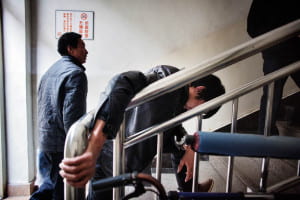
“Arriving at a hospital seven hours’ drive from his remote village in the mountains, former gold miner Mr He Quangui struggles at the foot of a flight of stairs to get to the room where he will be warded. He is almost totally out of breath. An air bubble had burst in his lung cavity, putting pressure on his lungs, the doctors told him. The doctor who received him took one look at the chest x-rays he brought with him and said ‘It’s a miracle you made it here.'”
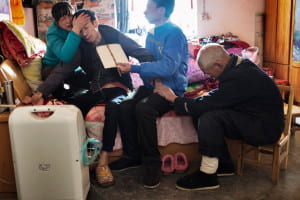
“Collapsing a second time in the same day, shortly after trying to take a pee on a commode, He Quangui is struggling to breathe, his son He Jingbo fanning him with a piece of cardboard while his wife Mi Shixiu and father He Decheng hold him, crying. He eventually recovers his breath. But in the wee hours of the next morning, he tried to kill himself to end the suffering.”
I’m a sophomore in Gallatin studying journalism (potentially concentrating in the Middle East?) and foreign languages. It would be great to be a foreign correspondent some day, and a fashion blogger on the side. A girl can dream.
Photography has always been an important facet for my family. My father raised me on his cameras, until I eventually got my own. It was the best feeling in the world. I take photos for numerous other personal reasons, and all I’ll say is that I find the medium very cathartic.
Currently, I work at Bang Bang Tattoo in the Lower East Side. When I’m not working or going to school, I’m either browsing the Internet, taking pictures, or sewing clothes. Most likely just sleeping, because I’m exhausted from my schedule!
© 2024 Photography Through the Lens of Magnum and VII
Theme by Anders Noren — Up ↑






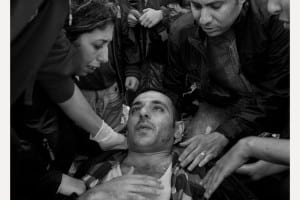
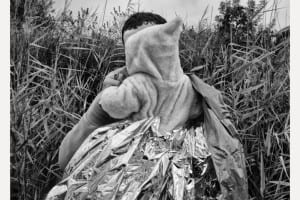
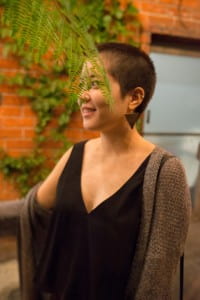
Recent Comments